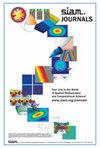通过在一个观测点和稀疏观测点测量的多频数据对移动点源进行成像(第二部分):三维近场案例
IF 2.3
3区 数学
Q3 COMPUTER SCIENCE, ARTIFICIAL INTELLIGENCE
引用次数: 0
摘要
SIAM 影像科学期刊》,第 17 卷第 3 期,第 1377-1414 页,2024 年 9 月。 摘要:本文介绍了一种提取移动点源轨迹信息的频域方法。该方法的关键在于分析三维稀疏观测点记录的多频近场数据。移动点源的辐射周期假定支持实轴,并且是先验已知的。与反固定源问题相反,我们需要对可观测和不可观测的测量位置进行分类。作者在之前的论文[SIAM J. Imaging Sci.,16 (2023),第 1535-1571 页]中首次提出了这些概念在远场机制中的类比。本文将推导出 [math] 中直线运动和圆周运动的可观测和不可观测测量位置。在近场情况下,我们验证了以包含轨迹的可观测位置为中心的最小环形区域可以为一类可接受的轨道函数成像。利用来自稀疏可观测位置的数据,可以重建轨迹的[数学]凸域。我们利用合成数据进行了密集的三维数值测试,以显示这种新算法的有效性和可行性。本文章由计算机程序翻译,如有差异,请以英文原文为准。
Imaging a Moving Point Source from Multifrequency Data Measured at One and Sparse Observation Points (Part II): Near-Field Case in 3D
SIAM Journal on Imaging Sciences, Volume 17, Issue 3, Page 1377-1414, September 2024.
Abstract.In this paper, we introduce a frequency-domain approach to extract information on the trajectory of a moving point source. The method hinges on the analysis of multifrequency near-field data recorded at one and sparse observation points in three dimensions. The radiating period of the moving point source is supposed to be supported on the real axis and a priori known. In contrast to inverse stationary source problems, one needs to classify observable and non-observable measurement positions. The analogues of these concepts in the far-field regime were first proposed in the authors’ previous paper [SIAM J. Imaging Sci., 16 (2023), pp. 1535–1571]. In this paper we shall derive the observable and non-observable measurement positions for straight and circular motions in [math]. In the near-field case, we verify that the smallest annular region centered at an observable position that contains the trajectory can be imaged for an admissible class of orbit functions. Using the data from sparse observable positions, it is possible to reconstruct the [math]-convex domain of the trajectory. Intensive 3D numerical tests with synthetic data are performed to show effectiveness and feasibility of this new algorithm.
Abstract.In this paper, we introduce a frequency-domain approach to extract information on the trajectory of a moving point source. The method hinges on the analysis of multifrequency near-field data recorded at one and sparse observation points in three dimensions. The radiating period of the moving point source is supposed to be supported on the real axis and a priori known. In contrast to inverse stationary source problems, one needs to classify observable and non-observable measurement positions. The analogues of these concepts in the far-field regime were first proposed in the authors’ previous paper [SIAM J. Imaging Sci., 16 (2023), pp. 1535–1571]. In this paper we shall derive the observable and non-observable measurement positions for straight and circular motions in [math]. In the near-field case, we verify that the smallest annular region centered at an observable position that contains the trajectory can be imaged for an admissible class of orbit functions. Using the data from sparse observable positions, it is possible to reconstruct the [math]-convex domain of the trajectory. Intensive 3D numerical tests with synthetic data are performed to show effectiveness and feasibility of this new algorithm.
求助全文
通过发布文献求助,成功后即可免费获取论文全文。
去求助
来源期刊

SIAM Journal on Imaging Sciences
COMPUTER SCIENCE, ARTIFICIAL INTELLIGENCE-COMPUTER SCIENCE, SOFTWARE ENGINEERING
CiteScore
3.80
自引率
4.80%
发文量
58
审稿时长
>12 weeks
期刊介绍:
SIAM Journal on Imaging Sciences (SIIMS) covers all areas of imaging sciences, broadly interpreted. It includes image formation, image processing, image analysis, image interpretation and understanding, imaging-related machine learning, and inverse problems in imaging; leading to applications to diverse areas in science, medicine, engineering, and other fields. The journal’s scope is meant to be broad enough to include areas now organized under the terms image processing, image analysis, computer graphics, computer vision, visual machine learning, and visualization. Formal approaches, at the level of mathematics and/or computations, as well as state-of-the-art practical results, are expected from manuscripts published in SIIMS. SIIMS is mathematically and computationally based, and offers a unique forum to highlight the commonality of methodology, models, and algorithms among diverse application areas of imaging sciences. SIIMS provides a broad authoritative source for fundamental results in imaging sciences, with a unique combination of mathematics and applications.
SIIMS covers a broad range of areas, including but not limited to image formation, image processing, image analysis, computer graphics, computer vision, visualization, image understanding, pattern analysis, machine intelligence, remote sensing, geoscience, signal processing, medical and biomedical imaging, and seismic imaging. The fundamental mathematical theories addressing imaging problems covered by SIIMS include, but are not limited to, harmonic analysis, partial differential equations, differential geometry, numerical analysis, information theory, learning, optimization, statistics, and probability. Research papers that innovate both in the fundamentals and in the applications are especially welcome. SIIMS focuses on conceptually new ideas, methods, and fundamentals as applied to all aspects of imaging sciences.
 求助内容:
求助内容: 应助结果提醒方式:
应助结果提醒方式:


